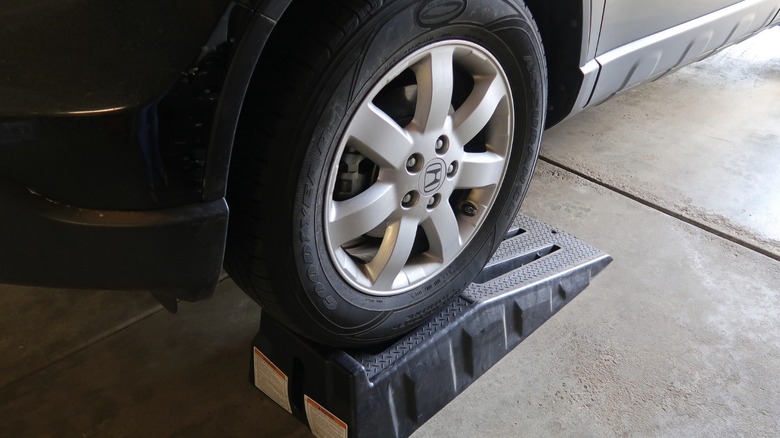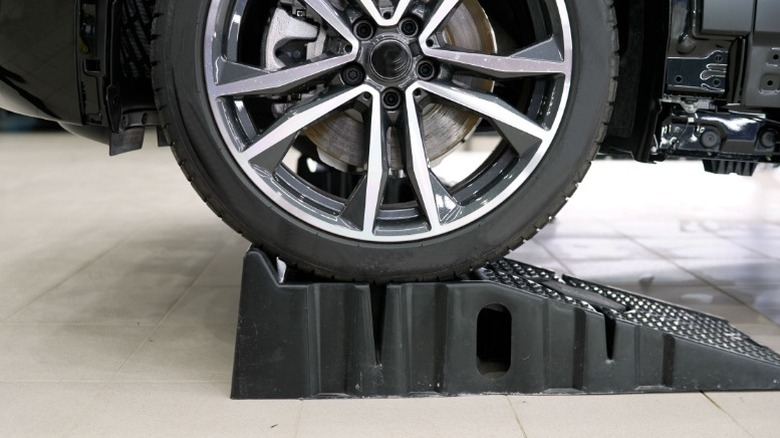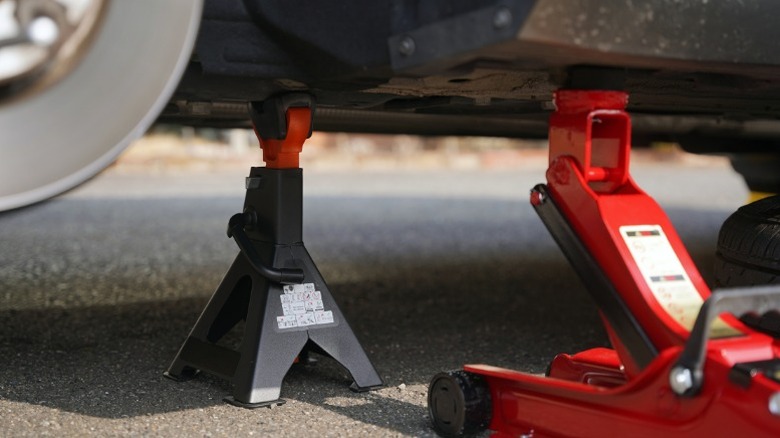Car Ramps For Oil Changes: How High Do They Need To Be & Are They Safe?
Our cars can do a lot of impressive stuff, including telling us when it's time to perform key maintenance tasks. However, they aren't capable of performing maintenance or repairs on their own. That means that if you want to keep your car in solid shape, you'll have to do these jobs yourself or pay a professional mechanic to tackle them for you. Fortunately, there are a lot of DIY auto jobs that even beginners can handle, including replacing the oil.
Changing your oil at home is a great way to save a bit of cash, but it's also an easy way to develop your auto maintenance skills, as well as one of the most affordable and effective forms of care you can perform for your vehicle. The process is relatively simple, even for automotive novices, and it only requires access to basic tools and supplies. However, you'll probably need to raise your car off the ground slightly to access the oil drain plug and oil filter. You can use a few different devices for this step, but car ramps are a popular choice, due to the convenience they offer.
Car ramps for oil changes don't need to be exceptionally tall. Most vehicle ramps provide between 6 and 10 inches of lift, although you can find options both shorter and taller. The important thing to consider is whether they provide enough space for you to slide under the car. If your vehicle sits extremely low to the ground, you may need a taller set of ramps. However, if you drive a large vehicle, you may not need ramps at all. If you're curious about whether ramps are safe or not, as well as some other options for lifting your car, stick around.
Are car ramps safe for oil changes?
Generally, car ramps are safe to use for oil changes, as long as you don't exceed the ramps' recommended weight capacity, that is. Vehicle ramps are built from robust materials, like metal or heavy-duty plastic and rubber, and are designed to support a set amount of weight. Ramps usually come in a set of two, with each ramp providing a specified weight capacity and the pair providing the combined weight capacity of both devices.
In order to determine whether or not a set of ramps will support your car, you need to look at a few specifications. First, check the ramps' weight capacity. If each ramp can support 3,000 pounds, the two ramps together can support a total of 6,000 pounds. In addition to those weight capacities, it's also common for ramp makers to provide a third number, either in addition to or in place of the first numbers. Gross vehicle weight (GVW) refers to the total weight of a vehicle, along with all of its fluids and a complete payload, including passengers and cargo.
For a set of ramps like the one described above with 6,000-pound total weight capacity, the product description may also include a 12,000-pound GVW capacity. That means that, because you'll only be supporting half of the vehicle with your ramps, you can safely lift a car with a GVW up to 12,000 pounds. The other piece of information you'll need to check is your vehicle's weight. You can usually find your car's GVW by checking the placard in the driver-side door jamb or by reading your owner's manual. Then, you can compare that weight to your ramps to determine whether they can support your car.
How do you use car ramps, and what else can you use to lift your vehicle?
As mentioned, car ramps are a popular choice for quick maintenance tasks like at-home oil replacements. These devices are commonly used for quick jobs that don't require you to remove the wheels, due, in large part, to how simple they are to use. You simply need to position the ramps evenly in front of your tires and make sure that your wheels are centered in front of the ramps so that your car's weight will be distributed evenly. Then, slowly drive onto the ramps. Once your wheels are on the flat part of the ramps, put your vehicle in park, activate the emergency or parking brake, and turn off the engine. For added security, you can then chalk one or both of the rear wheels, meaning you can put a block of wood or specially-designed wheel chalk behind the rear wheels to prevent the car from rolling off the ramps if there's an accident.
While ramps are great for performing jobs that don't require the removal of the wheels, like oil replacements, coolant flushes, and exhaust work, they aren't ideal for anything that necessitates the removal of the wheels or tires, like a brake job. If you need to remove your car's wheels, you'll have to use a lift or jack. There are various types of automotive jacks, but some of the best variations to own for DIY auto work include floor jacks. These devices roll under your vehicle, allowing you to use a lever to lift the car with ease. Remember, though, no matter what kind of jack you use, you should also place a couple of jack stands beneath the vehicle to catch it in the event of jack failure.


